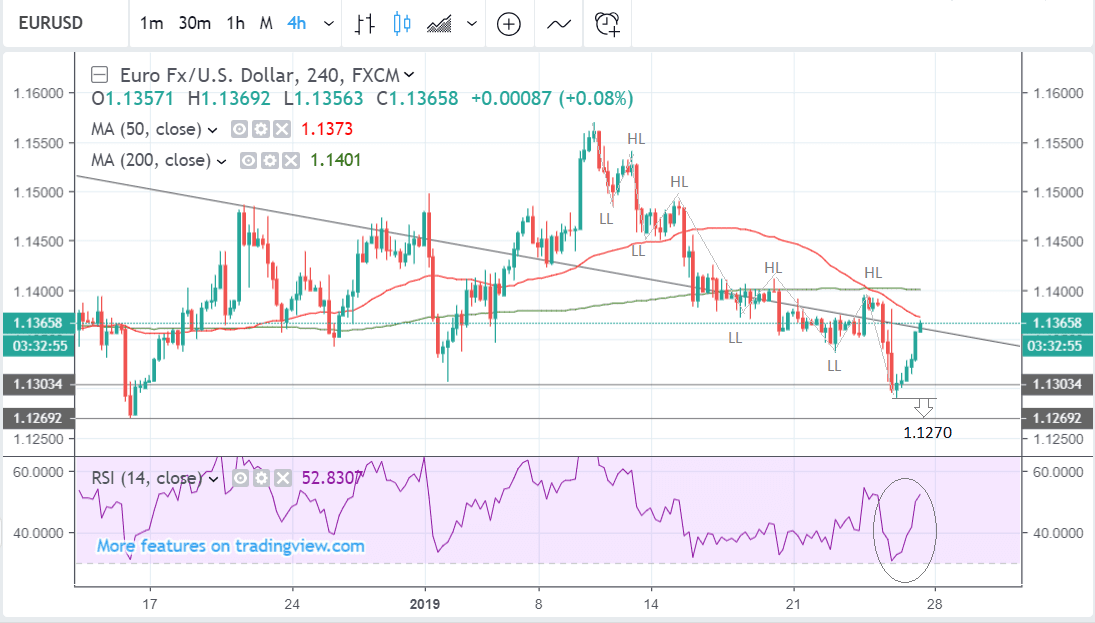Euro-to-Dollar Rate Week Ahead: Decidedly Mixed, Eurozone GDP is Key Data Event

Image © Adobe Images
- Pair is trading in volatile swings within a range
- Rapidly changing fundamentals to be influential
- Break of lows would renew bearish case
Techical studies suggest the Euro-Dollar exchange rate should remain relatively bouyant but the outcome of Eurozone GDP data and the U.S. Federal Reserve's mid-week policy meeting could provide some volatility for the pair
The exchange rate is to commence the new week at 1.14 after the Euro secured a marginal gain during the previous week thanks primarily to a strong gain of 0.78% recorded on Friday.
Technical studies show the EUR/USD pair has however fallen back down from January 10 highs above 1.15 after failing to break above a trendline and is now once again trading on top of the 200-day moving average (MA), putting it well within a familiar range. The 200-day MA has supported the exchange rate since October 2018, if the EUR/USD breaks below the 200-day MA, the outlook will flip to bearish.
The failure to follow-through after the initial break above the long-term trendline at the start of 2019 is a negative sign.
In addition, the longer-term trend since the start of 2018 has been bearish and there is tentative evidence that the short-term trend may also be turning bearish.
The sequence of lower lows and lower highs on the 4hr chart suggests the possibility the short-term trend may now be bearish. More than two lower lows (LL) and lower highs (LH) in a row can be one of the first signs that a new downtrend is unfolding.
A break below the 1.1270 lows would confirm a break below the 200-day MA and a continuation of the new downtrend to the next target at 1.1195.
One contrary sign on the 4hr chart which detracts from the bearish case, however, is the strong rebound in the exchange rate over the last 24hrs.
This rebound has been accompanied by especially strong upside momentum and could be a sign of a reversal in the short-term trend, although it is still too early to say for sure.
Time to move your money? Get 3-5% more currency than your bank would offer by using the services of foreign exchange specialists at RationalFX. A specialist broker can deliver you an exchange rate closer to the real market rate, thereby saving you substantial quantities of currency. Find out more here.
* Advertisement
The Euro this Week
Wednesday will give us several confidence indexes for January. The confidence trend has so far remained negative in the Eurozone, but the gain of 0.4 points in the preliminary version of consumer confidence in January is a good sign.
However, the PMI indexes have continued to fall; the Euroland composite index dropped from 51.1 to 50.7, its lowest level since summer 2013.
Eurozone GDP data is due out on Thursday, January 31, and this month's release will likely attract more attention than usual owing to the recent slowdown in Eurozone economic growth.
Consensus estimates see growth coming in 0.2% quarter-on-quarter for the fourth quarter of 2018, The year-on-year rate is forecast to read at 1.2% in December.
A number below expectation would likely prompt Euro weakness, as it would suggest to markets the European Central Bank (ECB) will become increasingly cautious on raising interest rates.
The further back the date of a first interest rate rise is pushed, the softer the outlook for Euro exchange rates become.
The Euro fell last week after ECB President Mario Draghi told journalists the ECB now believe that risks to the outlook for the Eurozone economy have moved to the downside.
"The near-term growth momentum is likely to be weaker than previously anticipated," said Draghi, adding significant stimulus is still needed to sustain inflation. This marks a more cautious tone from the ECB which appears to have dropped its previous optimism on the trajectory of the Eurozone's economy in 2019, and makes it unlikely we will see an interest rate rise come under the stewardship of Draghi who will hand over the reins to a new President in 2020.
The U.S. Dollar this Week
The US Dollar index - a measure of broader Dollar performance - closed down 0.8% last week as demand for the safety of the Dollar declined as investor sentiment improved.
The S&P500 closed the week up 0.9%, the U.S. Dollar fell, and U.S. bond yields rose.
We expect overall sentiment to remain a driver of Dollar performance over coming days; and it appears that the good mood might extend.
Sentiment has improved on news that the U.S. government shutdown would temporarily end.
U.S. President Trump and Congress leaders reached an agreement to reopen the government for three weeks, until 15 February, following a 35-day shutdown – the longest in U.S. history. Further talks would be held over Trump’s demands for financing to build a wall on the U.S.-Mexico border
Also weighing on the Dollar was a report the Federal Reserve was considering whether to slow down the reduction of its treasury bond holdings in line with a more cautious approach towards tightening monetary policy.
The highlight for the week ahead will be the Fed's policy decision, due on January 30 where it is all but certain to leave U.S. interest rates unchanged at a range of 2.25% to 2.50% after it increased them four times last year.
"The Fed has signalled patience and flexibility with policy as it takes stock of its series of rate increases over recent years and a weakening global backdrop that’s expected to put a headwind on the world’s biggest economy," says Joe Manimbo, a foreign exchange analyst with Western Union.
While the Fed next week may not sound overtly dovish, Manimbo expects a tone that might emphasise caution and thus do little to alter very low expectations for policymakers to raise rates this year.
The main data event to watch in the coming week will be the release of U.S. non-farm payroll numbers, due out on Friday, February 01.
Markets are looking for a reading of 165K for January, down on the previous month's 312K. Average hourly earnings could be important, markets are forecasting a reading of 3.2 year-on-year and 0.3% month-on-month.
Also out on Friday will be survey data in the form of the ISM Manufacturing PMI for January. This will give the most up-to-date indicator of how the U.S. economy is faring at the beginning of the year, and should also shed some light on what impact the recent government shutdown has had on activity.
A reading fo 54.1 is forecast.
Time to move your money? Get 3-5% more currency than your bank would offer by using the services of foreign exchange specialists at RationalFX. A specialist broker can deliver you an exchange rate closer to the real market rate, thereby saving you substantial quantities of currency. Find out more here.
* Advertisement





